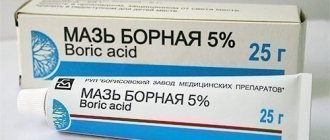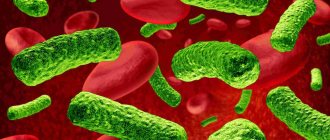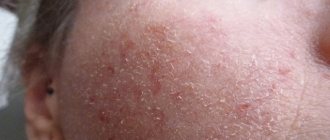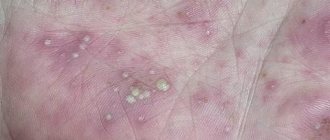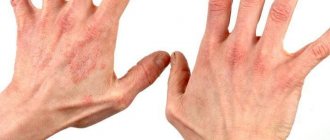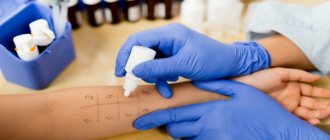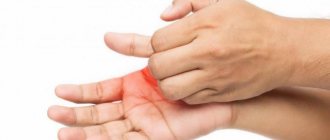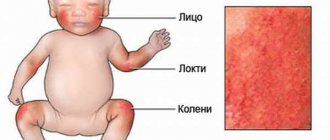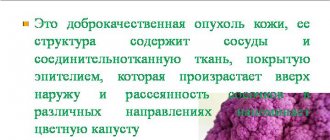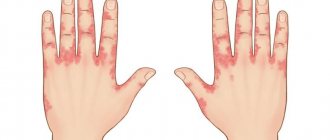Dry air, alkalis and acids, detergents, infections, chronic stress - all this is a test for the skin. With constant exposure to one or more of these factors, as well as with a hereditary predisposition to dermatitis, the skin sooner or later ceases to cope with its protective functions. He becomes parched and irritated. Over time, this leads to inflammation and redness. Cracks form on the arms and legs. The once smooth surface of the epidermis becomes dried out and cracked. This is how the disease manifests itself, which is called asteatotic or dry eczema.
What is dry eczema
Dry eczema is a type of dermatitis that is accompanied by dryness, irritation of the skin, and the appearance of cracks on it. The pathology affects large surfaces of the epidermis, and the irritated areas resemble the bed of a dried up river. This condition is often observed in people with atopic diathesis.
The pathology is difficult to cure. It can develop over the years; in the summer there is a remission, in the winter there is an exacerbation. Over time, the process becomes permanent and is accompanied by complications, for example, microbial or coin-shaped eczema. Therefore, it is important to track the disease and at an early stage contact a dermatologist - a specialist who knows what dry eczema is, how to cure it, and avoid relapse.
Why does it appear
The reasons why dry eczema occurs can be both internal and external. Environmental factors are the most obvious aggressors. These include sudden changes in temperature, too dry or humid air, frequent prolonged contact with water, as well as allergens with which we come into contact at work and at home - alkalis, acids, glue, detergents, construction solutions. If they come into regular contact with the skin, they cause chronic irritation. A similar effect can occur with constant contact with synthetic fabrics, sweat, jewelry, chemical compounds in cosmetics, rubber and latex products, dust, wool, and pollen.
It is important to track the disease and at an early stage contact a dermatologist - a specialist who knows what dry eczema is, how to cure it, and avoid relapse.
Internal causes of dry eczema include the following:
- the presence of dermatoses in close relatives;
- past viral, bacterial, fungal and parasitic infections;
- pathologies of the immune system;
- metabolic, endocrine disorders;
- diseases of the kidneys, liver, digestive system;
- the presence of other allergic diseases, sensitization (hypersensitivity) of the body;
- psychosomatic diseases, chronic stress.
Dry eczema is considered an occupational disease of builders, artists, mechanics, and drivers.
Drug treatment
If you start treatment on time, this will reduce the scale of not only the lesion, but also subsequent relapses.
Treatment of dry eczema is carried out comprehensively and, in addition to medications, also includes a hypoallergenic diet, sanitation of chronic infectious foci, a healthy lifestyle, good sleep, strengthening the immune system, eliminating stress and exposure to adverse external factors.
When the disease worsens, drug treatment is required, including:
- Local agents: hormonal and non-hormonal ointments, creams, emulsions, etc. to get rid of itching and soften the skin, for example, non-hormonal Tacrolimus, Pimecrolimus and hormonal Dermovate, Sinaflan, Sinalar;
- antihistamines to eliminate allergies;
- immunomodulatory and vitamin preparations to strengthen the immune system;
- sedatives to reduce nervous stress and insomnia;
- means for normalizing intestinal microflora;
- when a secondary infection occurs, antibiotics or antifungal drugs;
- physiotherapeutic procedures.
Only a dermatologist can develop complete therapeutic tactics, and the sooner you contact him, the more effective the treatment will be and the less time it will take.
Symptoms
The pathology is accompanied by three characteristic symptoms:
- dry skin with a characteristic pattern;
- itching;
- formation of cracks.
Unlike other types of eczema, there are no blisters with serous fluid inside.
Dry skin and the appearance of skin relief are the main symptoms. First, the skin tightens, then it becomes rough, rough, and the affected areas become red and inflamed. As the disease develops, scarlet structured rashes appear, then their number increases, individual papules unite into plaques.
Then skin itching appears, which worsens the quality of life, causes nervous tension, breakdowns, and depression. In this state, night sleep is disturbed, daytime drowsiness appears, and the body's resistance decreases.
After itching occurs, the skin becomes covered with cracks, and the pain intensifies. The epidermis in the affected area cracks and acquires a characteristic craquelure pattern. This is called "eczema craquelé". In advanced cases, the symptoms are accompanied by exudate and weeping, and after they dry out, a rough scarlet crust forms.
Dry eczema gets worse during the winter months. Warm weather and constant use of emollients help the skin get rid of the symptoms of asteatotic dermatitis.
Localization
Initially, one small lesion appears, and subsequently the neighboring areas become dry. Depending on the cause of the pathology, the location may vary.
- Dry eczema on the hands is more often diagnosed on the forearm and hands. Here, irritation occurs due to prolonged exposure to aggressive chemicals and allergens.
- Dry eczema on the legs develops more often under the influence of fungal invasion, an allergic reaction to synthetics. Uncomfortable shoes contribute. Eczema on the legs can be found in the foot and lower leg area.
- Dry eczema on the fingers is often a consequence of constant contact with water, household chemicals, acids, and alkalis. The pathological process may involve one or more fingers. Without treatment for eczema on the fingers, the lesion spreads to neighboring areas. As a result, dry eczema develops on the palms.
Top 10 remedies for treating eczema at home using folk remedies
Eczema is a disease whose treatment should not be delayed.
Anyone can get eczema and it affects everyone, including children. It is transmitted for many reasons, among which there may be internal factors, such as organ diseases, poor metabolism and immune defense, and external ones, that is, various allergens.
This is a non-communicable disease, so it is safe to be in contact with someone who is sick.
Symptoms of eczema can be relieved with both medications and traditional methods.
Treatment of eczema is possible at home, but in this case the therapy must be approached very carefully, because you can seriously harm your health if various folk remedies are used incorrectly.
The best way out is to contact your doctor, a dermatologist, so that he can diagnose the disease and prescribe the necessary medications and give recommendations.
Causes of eczema
Scientists have not yet identified the root cause of eczema. As with most skin diseases, there can be several factors. Doctors say that most often the disease appears in people with an allergic reaction.
The disease can appear due to both external and internal factors.
External factors:
- Overdose of medications, especially if they contain hormones.
- The use of shampoos containing components to which the patient is sensitive or which causes an allergic reaction.
- Masks, balms, and other care products may also not be suitable and cause symptoms.
- Allergic reaction to dyes.
- Poor environmental situation in the place of residence.
Internal factors:
- Poor functioning of the endocrine system, disruption of hormone production. Diabetes and obesity often lead to eczema because sebum production increases.
- Heredity. Often patients have parents who were or are suffering from a similar disease. Because of this factor, men are more likely to suffer.
- Violation of the emotional background. A single stress or depression can instantly cause symptoms to appear.
- Diseases of organs and systems such as the gastrointestinal tract, cardiovascular system, and central nervous system.
- Impaired immune defense, slow metabolism.
Find out more
Types of eczema for self-treatment
Many patients with eczema on the arms, legs, head and other localizations ask the question: “How to cure eczema with folk remedies at home?” It is possible to cure the disease in its initial stages, but in a chronic course it is impossible.
- True eczema is characterized by periodic exacerbations and relapses. Namely, this variety flows into the chronic stage.
- Microbial. It is provoked by the appearance of microbes, fungal formations, bacterial infections and skin burns.
- Dyshidrotic - localized on the extremities: arms, palms, in the area between the fingers, legs.
- Seborrheic eczema is localized in the scalp area. Without proper treatment, crusts form on the scalp.
- Occupational eczema - the name was taken due to the fact that in some enterprises workers, due to frequent contact with substances containing an allergen, develop symptoms of eczema. They disappear immediately after a change in activity and lack of contact with this substance.
- Weeping - localized on the limbs, head. Weeping appears under the crusts on the skin.
- Children's eczema. How to cure eczema with folk remedies in children? In this case, it would be best to go to the doctor, as it could harm the child.
Symptoms of eczema
Symptoms vary depending on the type of disease.
For example, with seborrheic eczema, flaking on the head and dandruff first appear. Crusts form, the inflamed areas unite and itch. In case of complications, symptoms spread to the ears and neck.
The disease is characterized by the appearance of inflammation in the affected areas in the form of redness. A rash appears, and depending on the type of eczema, the type of rash also changes.
In the area of the disease, the skin itches, sometimes the itching becomes unbearable. The rashes have blisters that can burst and leave cracks in the skin. In the affected areas, the skin becomes very dry and cracks.
When areas become wet, the liquid dries out and yellowish crusts form.
Treating eczema at home
You can cure eczema at the initial stage without the intervention of modern medicine, but using only natural home medicine products.
But we must take into account that it would be best to consult a specialist, since the patient may be allergic to the selected ingredients. Due to an allergic reaction, symptoms may worsen significantly.
The chronic stage cannot be cured only with grandmother’s recipes; complex treatment, including various forms of drugs, cannot be avoided.
Treatment of eczema with grease at home
Solidol has found widespread use against many dermatological diseases. But it is necessary to use medical grease, which undergoes special cleaning.
It is sold in pharmacies in ointments and in pure form. If solid oil has the desired effect on the patient, then you should continue to use ointments with this product in the composition or even use it in its pure form.
Pure solid oil is more effective and healthier.
Solid oil has the following advantages:
- In more than half of the cases, patients observe a noticeable positive trend in the symptoms of the disease.
- It is very easy to use solid oil; you do not need to carry out special procedures or prepare products based on it in advance. You can use it at home; this folk remedy is very effective for eczema and has many positive reviews from those cured on the forums.
- Quick treatment - a few applications are enough to eliminate dryness, rashes, and scaly skin.
- Naturalness of the component. This is a natural product, which means it will rarely cause allergies.
- The results of therapy remain for a long time.
Pharmacies sell ointments based on grease. Depending on the composition and percentage of solid oil, a suitable ointment is used. These include Antipsor, Markina ointment, Cartolin ointment, Rybakova, Magnipsor. They contain various plant extracts and mineral components.
At home, with positive dynamics in the use of ointments, solid oil is used in its pure form. To do this, apply it to the skin for 10 minutes and wash off with tar soap. The next procedure lasts twenty minutes, the third thirty, and so on. This is done for only six procedures; on the seventh, a compress of grease is applied. The duration of treatment is 2-3 months.
Treating eczema with St. John's wort oil at home
St. John's wort oil can be made at home. To do this, the plant is crushed and mixed with sunflower or other oil, left for 14-20 days, shaking every three days. The higher the percentage (concentration) of St. John's wort, the more active the oil will be. To increase it, St. John's wort flowers are used. St. John's wort oil is left in the light. After all procedures, the oil is filtered.
You can find St. John's wort everywhere throughout the summer. St. John's wort treats eczema, burns, and is effective in stretching muscles. Some people even take the concentrate orally.
Treating eczema with black seed oil at home
An oriental plant, it is usually used as a seasoning, but is also widely known as a medicinal plant. Ancient historians and doctors claimed that cumin has high healing properties and returns energy to a person.
Cumin is used in the form of essential oil. It is not only used for eczema, but also for colds, intestinal diseases and other dermatological diseases.
Cumin oil is an expensive product, its price ranges from 800 to 2000 rubles. If it is sold at a lower price, then this indicates that the product is not natural. Cumin oil can be ordered online.
Cumin is taken orally, as it improves immunodefense and the activity of the gastrointestinal tract
The application regimen is as follows: cumin oil is applied to the diseased areas of the dermis (moisturized), after the procedure, doctors advise to go for a walk in the sun.
There is a recipe for using cumin oil in the form of a decoction for weeping eczema:
- Boil cumin at the rate of 1 tablespoon of cumin per 250 ml of water.
- The decoction is infused for 150 -200 minutes.
- The decoction is used to treat skin areas externally.
Homemade mustard for eczema
Dry mustard is used to actively treat skin diseases. For eczema, it is most effective when affecting the fingers and palms. Mustard is diluted in water (boiling water), stirred until smooth. Pour into a bowl and place your hands in it. The temperature of the mixture should not be too hot so that the temperature can be tolerated. The hand bath should be done for 15 minutes.
With daily use, it guarantees skin hydration to prevent the appearance of skin cracks, wounds, itching, and redness.
With a small affected area and the initial stage of the disease, symptoms go away very quickly.
Swamp duckweed at home
The leaves of this plant are widely known for containing many useful substances, such as iodine and bromine. Duckweed accelerates the healing of affected areas.
Duckweed is used in its pure form or tinctures are prepared from them:
- The duckweed is crushed, mixed with honey in a 1:1 ratio, placed in the refrigerator, and this mixture must be taken orally. Duckweed increases the effectiveness of other medications.
- A special tincture is made from the plant, for this purpose it is washed and then filled with alcohol. The mixture should be in a dark place.
Pine oil at home
Doctors recommend using pine oil for preventive purposes, as it regenerates affected areas of the skin, reduces inflammation, peeling, and itching. uh
To make your own oil, you need to use pine needles, which are usually plentiful in March. Then, in a 1:1 ratio, fill all the needles with pine needles. With this method, the oil should sit for about 15-20 days.
Sea salt
Many patients prefer to take baths with salt, as it dries the skin and has a positive effect on it. Fill a special container with water and add sea salt. Dip your hands into the water with salt, wait until the water cools, then carefully check that you have taken everything.
Diet and adherence
For eczema, you must follow a special diet that excludes any allergens from the patient’s diet. Some foods are allowed to be eaten once every three days, if they contain few allergens.
So, it is better to steam food than to fry it. You should eat lean meat. Fatty varieties such as pork are slow to digest.
It is prohibited to consume seafood, red foods (fruits and vegetables), flour, sweet, spicy, salty, smoked, sausages, honey, eggs and whole milk.
The patient should definitely give up bad habits, begin to experience light physical activity, monitor their sleep and diet, and take additional vitamins.
Source: https://www.dermatit.net/ekzema/lechenie-ekzemy-v-domashnih-usloviyah-narodnymi-sredstvami/
Diagnostics
Most often, a visual examination is sufficient for the treating dermatologist to diagnose dry eczema. The disease is indicated by characteristic dry skin and skin pattern, localization zones, as well as the absence of vesicles (vesicles filled with serous contents).
Other forms of subacute dermatoses – contact, congestive and atopic dermatitis – should be distinguished from dry eczema. Although patients may have several forms at once. If diagnosis is difficult, a skin biopsy may be necessary. Having determined the cause of the condition, the specialist will give recommendations on how to treat dry eczema.
Therapy methods
Treatment of dry eczema on the hands and feet is a long process. Timely therapy can prevent the disease from becoming chronic, prevent complications and achieve stable remission for a long period.
Medications
To cure dry eczema, official medicine suggests the following measures:
- Local external treatment aimed at restoring the skin. The patient is prescribed creams and ointments based on lactic acid, glycerin and fat-soluble vitamins. Therapy helps to quickly eliminate the main symptoms, but it must be combined with other complex remedies.
- Elimination of relapses. During an exacerbation, hormonal anti-inflammatory drugs are applied to the affected areas.
- Treatment of complications. To get rid of an attached fungal infection, you should apply a combination ointment with an antibiotic.
- Reduced hypersensitivity reactions. For allergic phenomena, taking antihistamines, limiting contact with allergens, and a special diet is indicated.
- Sedative therapy. Therapeutic measures are prescribed to maintain normal functioning of the nervous system.
- General strengthening therapy. Includes taking vitamins and dietary supplements.
ethnoscience
Treatment with folk remedies will not replace formal therapy, but will be a good addition to it. Here are the most popular recipes:
- Lotions with potatoes. Apply a cotton wool soaked in freshly squeezed potato juice to the affected skin for half an hour and wrap it with a bandage. Repeat this 3 times a day. Instead of juice to treat dry eczema, you can put squeezed vegetable pulp, mashed into a paste, under a compress.
- Cabbage compresses. Boil white cabbage leaves in milk and apply to the affected area. This can be done four times a day. According to another recipe, grind the cabbage in a blender and mix with the yolk of a chicken egg, put the pulp on the skin and cover with a gauze bandage. This remedy is applied 2 times a day.
- Berry compresses. Mix 40 g of viburnum and currant berries and pour a liter of boiling water. When the infusion has cooled, soak a bandage in it and apply to the affected skin for half an hour. Repeat daily.
- Sea buckthorn oil. Just soak a bandage in it and wrap the affected areas. This is an effective way to treat dry eczema on the hands using folk remedies.
- Herbal infusion. Mix 20 g of chamomile and calendula flowers with 10 g of dry sage, pour 0.5 liters of boiling water. When the mixture has cooled, make compresses from it 3 times a day.
- Sunflower oil baths. Heat the unrefined oil in a water bath, pour into a bowl and soak your palms or feet for 15 minutes. Upon completion of the procedure, remove any remaining oil with paper towels, wash the skin with warm water and lubricate with glycerin.
- Compress with Kalanchoe. Squeeze the juice of 1 leaf of the plant onto sterile cotton wool and apply to the inflamed areas. The recipe is convenient to use to treat eczema on the fingers.
Diet
During an exacerbation, you need to exclude fruits, spicy, salty, smoked foods, and preserves. It is undesirable to eat garlic, onions, eggs in any form. If eczema began due to an allergy, you need to remove baked goods and sweets, fatty meats, corn and sweet peppers from your diet. Milk and cream are prohibited, only fermented milk products are allowed.

Vegetables and berries can be eaten as a separate dish or added during cooking.
Very useful for dry eczema:
- vegetables (beets, zucchini, pumpkin, other melons);
- parsley and dill;
- berries (raspberries, black currants, blueberries, sea buckthorn).
It is healthy to eat baked or boiled fish and lean meat, and drink freshly squeezed beet and carrot juices.
It is better to get recommendations on how to treat dry eczema on the hands and feet from your doctor. People who have independently gotten rid of the disease using folk methods speak about the effectiveness of certain remedies. But it is precisely against the background of self-medication that mixed forms of dermatitis often develop. Therefore, before treating dry eczema using folk remedies, it is necessary to achieve a period of remission. This can only be done with diet, lifestyle changes and drug therapy.
The disease is prone to exacerbations. It is impossible to forget about dry eczema on your feet or hands forever. But if you strictly follow your doctor’s recommendations, you can keep your skin in good condition for a long time, which will serve as the best prevention of relapse.
Effective ointments
The use of systemic agents alone is not enough; it is necessary to influence the lesions with the help of effective external agents to speed up the healing process and prevent infection from entering the blood. Most often, specialists prescribe the following medications:
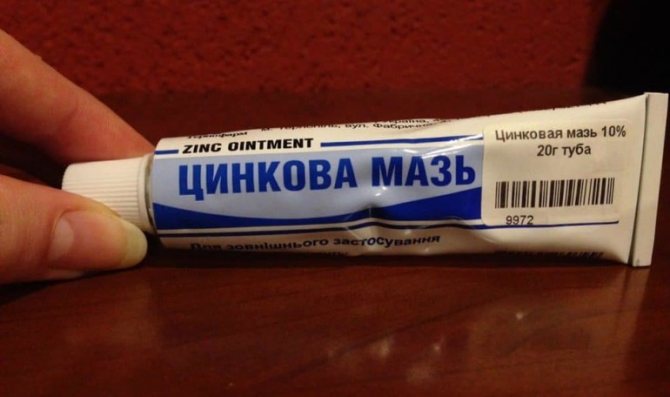
- Advantan is a hormonal drug based on methylprednisolone. Available in the form of cream and ointment, it is used for any dermatological pathologies accompanied by burning and itching. Allows you to quickly eliminate severe symptoms and speed up healing.
- Triderm is a combined hormonal medicine containing betamethasone. In addition, the composition contains clotrimazole, which has an effect on fungal infections, as well as gentamicin, which has anti-inflammatory and antimicrobial properties. Thanks to its complex effects, the drug is suitable for the treatment of dry eczema, cracks in the hands as the disease progresses.
- Salicylic ointment is a keratolytic agent based on salicylic acid. When treating lesions, it helps to soften and remove dead cells, stimulates tissue regeneration processes, and has a drying effect.
- Zinc ointment is a preparation based on zinc oxide. The mechanism of action is similar to Salicylic ointment. It has an anti-inflammatory, regenerating, antiseptic and drying effect.
- Radevit is an ointment that stimulates the tissue healing process. The composition contains components that have a softening and moisturizing effect.
Any of the drugs is prescribed by a specialist. Self-use may cause complications.
